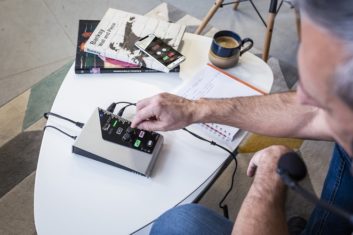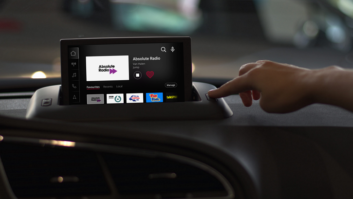 AEQ has a new codec for remote broadcasting; we asked Roberto Tejero, right, AEQ product manager and expert trainer, about it as part of our recent ebook about remote radio.
AEQ has a new codec for remote broadcasting; we asked Roberto Tejero, right, AEQ product manager and expert trainer, about it as part of our recent ebook about remote radio.
RW: What prompted it, and how does it reflect trends in radio workflows?
Roberto Tejero: Radio has historically been the most flexible, immediate and dynamic media. Stations have been trying for a long time to prevent regular contributors or collaborators having to travel to the station. Thousands of ALIO audio codecs have been installed on the home desks of regular participants of talk shows, commentators, correspondents and experts.
The pandemic has accelerated the trend. After the first confinement, all radio organizations have begun to facilitate technical resources so that their hosts and regular guests and contributors can work remotely.
The budget for this has put a lot of strain on many stations, and they have started looking for non-professional solutions. Dropouts, artifacts and faulty sound are common.
 Our mission is to adapt to the needs of changing environments. After almost exhausting our stock of the Phoenix ALIO portable audio codec, and seeing the need to produce a device that is easier to operate, adapted to non-technical personnel, we developed TALENT, which is a new portable audio codec, with fantastic design and small dimensions.
Our mission is to adapt to the needs of changing environments. After almost exhausting our stock of the Phoenix ALIO portable audio codec, and seeing the need to produce a device that is easier to operate, adapted to non-technical personnel, we developed TALENT, which is a new portable audio codec, with fantastic design and small dimensions.
It is simple to connect and allows transmission of a high-quality stereo audio channel. With a simple, domestic internet connection or wireless 3G / 4G / 5G data and a headset, you can make radio at home or from anywhere easily and safely.
RW: Generally speaking, what level of home connectivity is needed to create reliable work-from-home operations?
Tejero: This problem doesn’t have a single solution. It depends on the quality of service of the telecommunications infrastructure at each location.
In many countries it is essential to be able to request a connection with guaranteed QoS from the service provider, either wired or wireless.
The good news is that a high-capacity connection is normally not required to be able to operate audio codecs from a remote location or home. A stable connection is enough to provide sufficient bandwidth for the encoding algorithm used.
An ideal environment is the use of fiber optics, but it is also possible to use ADSL connections if they have reasonable latency and bandwidth. In numbers, for radio broadcast quality, OPUS encoding, a stable bandwidth of 400 kbps and a latency of less than 100 ms is sufficient.
RW: What other considerations are stations dealing with now?
Tejero: There are many challenges when it comes to outside radio broadcasting. Almost more important than latency and audio quality are the costs involved. This affects both large corporations and small radio stations to different degrees.
The fact that hosts are producing their shows from home at least implies a minimum investment in audio codecs. This expense can be multiplied by hundreds of audio codecs for each possible collaborator who goes on the air.
In addition to responding to the requirements of simple handling, TALENT has a suitable price for any broadcaster. It eliminates the need to purchase more expensive audio codecs or the purchase of mobile devices dedicated exclusively to broadcast software applications.
 RW: Are air talent connecting wirelessly or via wired connection from home?
RW: Are air talent connecting wirelessly or via wired connection from home?
Tejero: That depends on the country. For example, in Spain, wired connections are the most reliable. This is the case in the urban areas of most developed countries.
In rural areas and countries with lower levels of development, quality wired connections are not always available and it may be a better solution to use a 3G / 4G router modem.
To respond to this situation, TALENT has an Ethernet interface through which it allows both wired and wireless connections. This interface can be connected to a local network with connectivity to a fiber optic service provider network, domestic ADSL or other wired connection. But you can also connect to a wireless router that provides connectivity through WiFi or through 3G / 4G / 5G wireless phone networks.
RW: Anything else we should know?
Tejero: We want to highlight the benefits that we have incorporated into a basic device as TALENT.
It does not need to be configured or operated by the user. You can simply speak without needing to touch any buttons, except Help if required. It also has a local app for smartphone, TALENT Pilot, allowing the user to control and configure the audio codec.
It supports all types of headphones, low or high impedance, and microphones, dynamic and condenser, as it features phantom power. It also has a Bluetooth connection so you can connect it to your mobile phone, do phone interviews and send them mixed to the studio.
It can be powered in many ways, depending on where and how you are: from the USB outlet of a PC, from a 5 to 15 volt outlet, such as a vehicle battery or a power bank, or from the mains power supply that comes with the unit.
Operation is very intuitive. It is intended for personnel without prior technical knowledge. Typically the station’s technician will hand it over to the user, ready to connect to the domestic router and the power source and start working.
For local control, the Talent audio codec has indicators and basic controls to make the necessary adjustments during the broadcast. It also has the app for smartphone so that somewhat expert users can connect it in places other than their home.
TALENT, connected by Bluetooth to a smartphone, allows you make telephone interviews or, alternatively, through applications such as Skype, WhatsApp or Zoom, among others. These latter provide high quality to the interviewee’s voice and mix them to program signal sent to the station through the IP connection.
Further, TALENT can be controlled remotely. This operation can be in parallel or even overriding the local controls of the equipment. Therefore, one of the most important buttons is the “HELP” button. This is used to call for attention or request remote assistance from the station’s technician.







